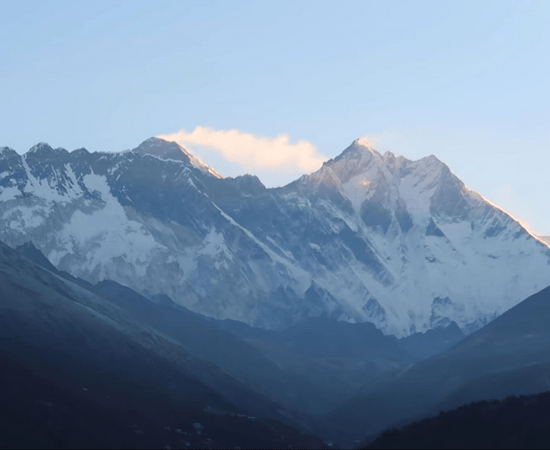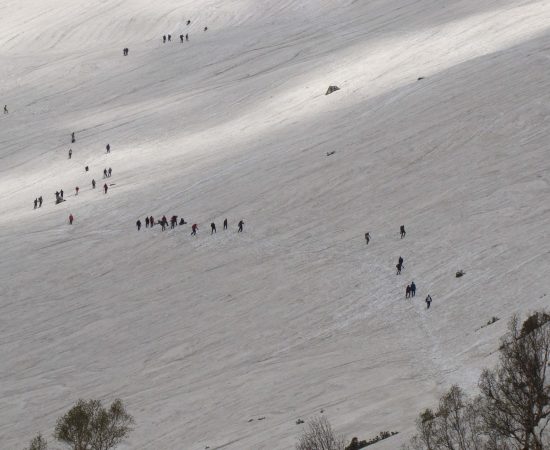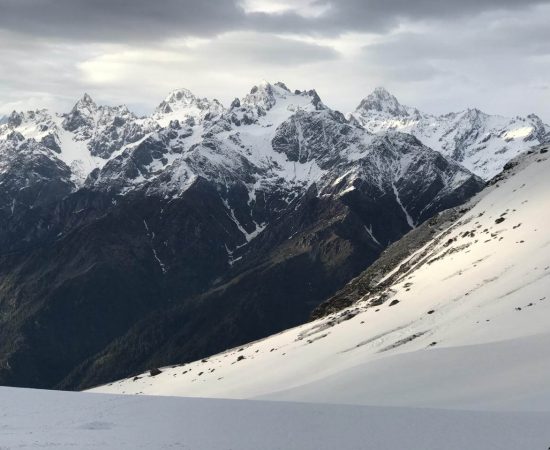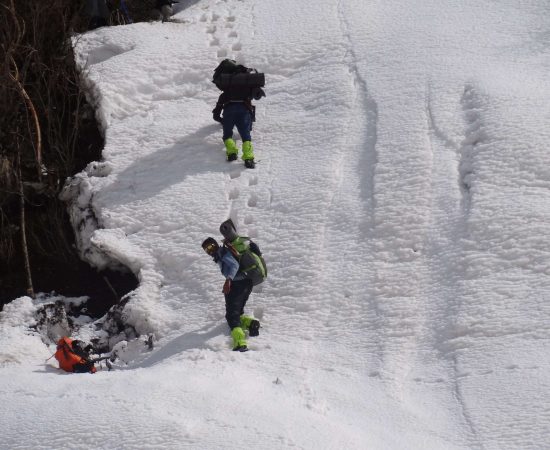Tarsar Marsar Trek
Kashmir
Rated 4.9/5.0 on TripAdvisor. 550 Reviews


Key Highlights
- Altitude : 4024 mts
- Time : 7 Days - 6 Nights
- Region: Kashmir
- Best Time: June,July,Sep,Oct
- Distance: 46 Kms
- Grade: Moderate
Overview
Tarsar Marsar Trek
When compared to Kashmir Great Lakes, Tarsar Marsar was one of the lesser-known hikes in the Kashmir valley until recently. However, because of its outstanding natural beauty and low degree of difficulty, the Tarsar Marsar journey has been drawing hikers from all across the nation. This walk is the ideal location for adventure seekers who appreciate unadulterated nature. The trip begins in the sleepy small town of Aru, which is just 11 kilometres from Pahalgam, the starting point of the renowned Amarnath Yatra. Aru is well known for its flower gardens and pony rides to some of the valley's best kept secrets. The trip begins along the Lidder River and eventually turns in the direction of the twin lakes. The twin lakes are revered by the locals because of the legend that surrounds them. According to folklore, there once was a shepherd who was approaching one of the lakes with a flock of a thousand sheep. He encountered an angel who instructed him to abandon his herd of sheep and go in the direction of the ridge in front of him in order to receive the Lord's blessing. But there was a catch—he was forbidden from looking back, and if he did, his blessing would be revoked. When the shepherd heard this, he immediately turned to go for the ridge without turning around to look at his flock of sheep. When the shepherd turned around, he discovered that all of his sheep had entered the lake to commit suicide, leaving just 200 of them on the ground. These 200 sheep likewise entered the water before the shepherd could rescue any of them. Sad and defeated, the shepherd traversed the hill and discovered a second lake that was an identical replica of the first. While he was sobbing next to the other lake, he saw his flock emerging from the water in the lake in front of him. He was completely taken aback when the angel reappeared and spoke to him once more, telling him that if he had maintained his faith and refused to turn around, all of his sheep would have been able to cross over without having to scale the perilous ridge. As a result, 200 of his sheep were left behind, and only 800 were able to do so. Since "Tar" means to pass and "Mar" means to die, the twin lakes' names are Tarsar and Marsar. See the fabled and lovely twin lakes as well as Sundersar, a lake known for its exquisite beauty and form.
Cost Per Person
Key Highlights
- Altitude : 4024 mts
- Time : 7 Days - 6 Nights
- Region: Kashmir
- Best Time: June,July,Sep,Oct
- Distance: 46 Kms
- Grade: Moderate
Complete
Itinerary of trek
If you want to travel with us, we may organise a taxi from Srinagar for the whole group, or you are welcome to make your own way to Aru Valley. Depending on traffic, the 103 kilometre voyage to Aru village takes around 3 hours. Saffron, a precious product growing in Jammu and Kashmir, is famously produced in Pampore, which is on the route. Afternoon arrival in Aru village, where we will set up camp. Take a stroll around Aru village and take in the stunning scenery.
We go as soon as we can after breakfast since the day is very lengthy. We'll bring a lunch with us for the trip. We will pass through Aru village, so if you need to make any last-minute purchases, now is your opportunity to do so. In the beginning of the walk, there is a steep ascent, and if it has just rained, the trail turns muddy and treacherous. This first climb will take around an hour to accomplish. The gradient becomes considerably more pleasant and simpler to walk on after the first section as we reach the deodar and pine forest. After many hours of walking in the shadow of the trees, the valley widens into a great expanse of open grassland with the Lidder river running next to it. The woodland extends on the other bank of the river. The landscape continues until we have to cross a river to get to Lidderwat. We'll take a stop for lunch right next to the river, where there are a few dhabas selling hot, delectable maggie and tea. We'll continue on in the direction of our campground after our break. The trip to the campground takes a little over an hour from here.
For energy throughout the journey, our morning will start with some yoga and breathing exercises. We will leave on our path to Sekhwas after breakfast. Right from the campground, the first portion of our walk begins with a sharp elevation. We pass through more deodar woodlands as the route slopes down to wide meadows with dense undergrowth. Even prickly blooms and many tiny berries will be present on these shrubby clumps. A tiny wooden bridge without railings will soon be used to cross a mountain creek that we will eventually follow. On the way, there will be some upward climbs, but the final descent to our campground is completely on a boulder section.
We will go for Tarsar, our first lake of the hike, today, making it a thrilling day. We begin slowly, taking in the breathtaking valley where we tented. Our route climbs steadily today without putting too much strain on you, but be cautious when you first start since the region is covered with nettle leaves (Bichoo Patta), which sting and itch and temporarily cause rashes. We go to the boulder portion after leaving the Tree line behind. Even though our trip leader will take, you should exercise extreme caution while navigating this stretch since after you go over it, everything becomes much easier. The last portion of today's hike takes you across a huge meadow where hundreds of sheep and goats are grazing, and gorgeous snow-capped mountains are visible in the distance. When we finally arrive to Tarsar Lake, we are astounded by the breathtaking beauty of the enormous emerald-blue lake that delights the eyes. To wake up to the breathtaking view once again, we spend the night camped just next to the lake.
Since the day is lengthy and there is a lot of walking to be done, we will get up early and attempt to depart as soon as we can. We'll depart from our campground and begin the ascent to Tarsar Pass. We zigzag along the high grade of the ascent to get onto the pass. The climb up the pass takes a little more than an hour. As we ascend to the pass's summit, the vista is truly breathtaking. We have a panoramic view of Tarsar Lake on one side and a lovely green valley with a mountain stream running through it on the other. After negotiating the hazardous ascent to the pass and having a rest, we begin our steep descent. The descent is fairly challenging since the slope is quite steep and the loose pebbles make it much harder to get down. After descending the steep fall, we will traverse the lovely, verdant valley that we could see from the top of the peak before beginning the ascent to Sundersar. Sundersar Lake will be directly in front of us after an arduous hour-long hike over rocks. Here, we'll set up camp for the night.
Wake up early because we have a long day ahead of us and a lot of work to do, but it will be well worth it. We go over to the other side of Sundersar Lake after an early breakfast and begin ascending the boulder portion. After navigating the stones, there is a little incline that we must climb to come to a saddle-like structure from which we can see Marsar from above. We do not descend to the lake since the people believe it to be a pit and severely warn against disobeying their beliefs. After taking pictures, we return the same route to our campground, where we pick up our lunch packs and begin the ascent to return. The majority of the way back is the same, except we bypass Tarsar Pass in favour of the path we used to get to Tarsar in the first place. We descend along the same path we had followed to get to Homwas, passing over our former campground at Sekhwas. We spend the night camped out here before making the last trek back to Aru village.
Early in the morning, we begin our descent, and two hours later, we are in Lidderwat, where we begin to recall the first few days of the walk. We might make a pit stop at the same Dhaba to bid Chachaji farewell and gather more pleasant memories of our journey. We descend to the settlement of Aru, where our taxis are waiting to return us to Srinagar. We bid our Trek Leader and Support crew farewell and depart for the trip back home with a sad heart and a wealth of memories.
Enquiry For Group Bookings
Guidelines
➽ Preparation for Trek
As you well know, the great Himalayan trek is one that requires careful preparation, a strategy that allows for enough flexibility to adapt to whatever challenges may arise.
Therefore, here are some things to consider before setting out on your trek:
⦿ Physically – You should start working out at least a month before signing up for a program if you want to be physically prepared for the rigours of a journey. Strengthen your legs by jogging and working out regularly to increase your stamina. To better acclimatise to the environment and increase your resilience on the walk, you should give up smoking and undertake breathing exercises twice a day. Engage in vigorous physical activity, such as playing sports, doing Yoga, or running.
⦿ Mentally –
Getting in shape physically is essential, but mental preparation is just as crucial for a successful walk. Take time to enjoy your regular activities, maintain a healthy diet and sleep schedule, and unwind before embarking on a hike. Predictions regarding the journey should not cause mental worry. Spend time with your closest pals to recharge your batteries and renew your spirit. Pre-trek preconceptions are unwarranted since the first contact with the other trekkers is certain to be a source of inspiration and energy. Conditions during the walk will contribute to the increase in mental readiness. The mental repercussions of physical disadvantages will not be ignored. So, when you hike, pay attention to different regions of your body and purposefully relax them. If you want to enjoy your hike, you should learn to loosen up a little, particularly in the hips. Think about your descent as a simple dance, and enjoy the natural rhythms that the path and your body can discover together gradually, whether you're on a flowing downhill route or a frightening slope. Try out a few new walking techniques to add some fun to your commute without worrying about getting somewhere in particular. Maintaining mental fitness mostly requires a willingness to relax and take in the journey, rather than subjecting oneself to undue stress.
⦿ Technically-
Get the right size hiking boots and go for it, from a technical standpoint. You should make use of 60 litres. To become acclimated to carrying heavy items, it is recommended to utilise a backpack on a regular basis. Get a hiking stick, a water bottle, some thermal socks, a fleece or feather coat, some long pants, a poncho, some flip-flops, and any devices you may need like a camera or a power bank (DSLR or digital camera).
Guidelines
➽ Things to Carry
- Good Trekking Boots: You need sturdy trekking boots with supportive high ankles. Don't bring your running shoes. U can carry extra floaters/flip flops also.
- Wear warm clothing, such three-layer coats, fleece upper, hollow fill or down-filled jackets. Carry full-sleeved T-shirt. Carry cotton hiking trek pants and warm pant for your lower body. Never bring shorts or jeans on a hike.
- Take top and bottom thermals with you.
- Quick dry towel with light weight and Personal toiletries. Suns cream lotion, sanitizer, tooth brush ad toothpaste, lip balm and antibacterial powder.
- Socks: Bring two pairs of regular socks and two pair of wool socks for wearing at night.
- A head torch is required.
- Sunglasses/ Goggle: UV-protected sunglasses are necessary to protect against sunlight and Snow Mountain.
- There should also be a woolen cap / balaclava, cap, neck gaiter cum face mask and warm fleece and waterproof summit gloves since it will be chilly. Keep waterproof gloves on hand since they become wet in the snow.
- Everyone taking part in the activity should have their own lunchbox, spoon, mug and water bottle/ hydration pack of 2 ltr.
- Raincoats/ponchos: Since snowfall and rain are frequent at high elevations, it is important to have one on hand so as to avoid getting wet.
- Trekking bag of 75 ltr with rain cover.
- Walking stik.
- Electronics: camera (optional) USB cable/USB solar charger, charger/earphones, Power bank fully charged.
- Personal first aid box. Emergency ration, energy bars, dry fruit, electoral/Ors
- Required Documents:
a) Registration Form
b) Medical Certificate (signed by a licensed MBBS physician)
c) NOC form (completed by the trekker)
d) 2 passport-size photos
e) ID Proof photo (not PAN)
g) Insurance upto 5 lac..
Guidelines
➽ How to Reach
Everyone must go to shirnagar.
Nishant Garden in Srinagar is the designated meeting point, and Peak Rovers will handle the rest of the trip's logistics from there. Please fly in instead of taking a bus. If you want to be on the safe side, you should go to Srinagar the day before your hike starts.
Shrinagar Accessibility: Several Possible Routes
1) The Srinagar bus station is accessible from all major cities through bus. It'll take you around 30 minutes to go from the bus station to Nishant Garden.
2) It would take you 45 to 65 minutes to reach Nishant Garden by cab from Srinagar International Airport, which has connections to all major airports in India.
3) There are two different train stops:
- a) The bus ride to Jammu Railway Station is around 260 kilometres and takes about 8 hours.
- b) It takes 6 hours to reach Srinagar by bus from Udhampur, which is about 200 kilometres distant.
➽ Trip Cost Includes
- Conveyance within the journey.
- Tents that can be shared.
- Advanced and knowledgeable himalayan adventure trips guide.
- Cooks, helpers, and other necessary personnel.
- Vegetarian meals (breakfast, lunch, and dinner) along the journey
- Every organisational prerequisite for a journey
- First aid kit with portal oxygen.
- Camping fees and forest permits.
- All permissions for hiking.
- All meals will be supplied while on the hike. Freshly cooked meals will include a mix of indian, chinese, and continental cuisines.
- Lodging at a hotel, guest house, home, or in tents.
- All of the group's trekking equipment (tents at base camp, use of base camp facilities)
- All trip workers, including porters and mules for everyday items (such as food, tents, and utensils)
➽ Trip cost Excludes
- Airfare or other forms of transportation costs.
- Meals and hotel accommodations.
- Personal costs include washing, cell charging, and lodge showers
- Entry permits or permission for the inner line for foreign participants.
- Personal apparel and hiking supplies, such as liners for sleeping bags and walking sticks, are required.
- Any expenditures associated with rescue efforts or an early expedition departure.
- Guides and sherpa crew are tipped.
- Personal porters to carry hikers' packs
- Personal liability insurance or emergency evacuation costs
- Personal purchases (such as bottles of mineral water, bottled or canned drinks, chocolate, dried fruit, presents, etc.).
- From and to the trailhead, food.
- 5% goods and service tax (gst).
Guidelines
➽ Special Casual Leaves
Government employee can avail the benefit of special casual leave when u join us for a trekking expedition. As per the rule of the pay commission, special casual leave can be availed for up to 30 days in a calendar years for trekking and mountaineering expeditions through a register organization. Himalayan adventure trips are a register adventure tour operator register with Indian mountaineering foundation and Himachal Pradesh tourism. Candidates have to apply for leave at least 30 days before the trek/expedition start.
Testimonials
➽ Provided By The Customers
Everything about our visit to Prashar lake was better than we could have imagined. From our initial contact with Himalayan Adventure Trips, we felt their genuine interest in learning about our group's goals and expectations, and our travels with them reinforced at every turn that they not only understood our requirements but also have the acute skill and expertise to achieve them. Having already had such a wonderful experience with this firm, I will be promoting a trek to Prashar lake to all my friends who share my passion for hiking and will specifically recommend that they work with this outfit. Absolutely fantastic; I have nothing but praise for it.
How useful was this post?
Click on a star to rate it!
Average rating 0 / 5. Vote count: 0
No votes so far! Be the first to rate this post.







